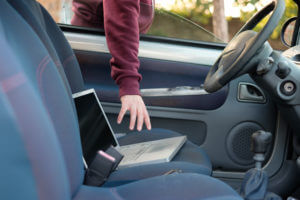Recently, we took a call from a client who was a key person in the organization. His laptop was stolen. He was understandably stressed because the laptop contained extremely confidential data. The device was also the primary device he used to do all of his work, since mobility was key to doing his job.
Fortunately, the client had used a very strong password and we were able to validate that in the days following the theft. Through our monitoring system, we were able to determine that the laptop had not connected to the internet. In this case, the laptop was likely wiped and resold.
We also setup a spare laptop for him from one his company had in inventory. We then rushed an order for a new laptop. Problem solved.
Unfortunately, not all laptop thefts end so well. While most thefts are grab and run – the system gets wiped and then sold in a back alley – sometimes the thief has the time and desire to use the device to capture licensing codes, credit card information or any data they can use for monetary gain.
While theft and loss of equipment is not 100% preventable, there are ways to minimize the risks when your laptop falls into the wrong hands.
Data Security
The biggest priority when securing your laptop against the risks of theft or loss is keeping your data out of the wrong hands. Fortunately, there are a number of things you can do to minimize the damage.
Limit Sensitive Data
Only keep data that you ABSOLUTELY need, on any laptop that you use outside of the office. That means no credit card numbers, social security numbers, or lists of passwords to server resources. Limiting the data you keep on your laptop will limit your exposure in case someone does access your lost or stolen device.
Secure Your Laptop with a Strong Password
Always be sure to use a strong password to secure your device. The general rule of thumb is a password with AT LEAST 8 characters that includes a combination of letters (upper and lowercase), numbers and symbols.
To make your password even more secure, try using a longer phrase that is both easy to remember and hard to crack. For example, a phrase like “My mom makes the best chicken pot pie!” makes a great password when combined with capital letters, numbers and symbols like this: MyMommakesth3b3stchick3np0tpi3!
Report Stolen Devices Immediately
Report lost or stolen laptops to your IT provider the MOMENT you realize it’s gone so that they can either leverage any monitoring devices to see if the device is online, or disable remote logins to the company network from the device. This will prevent access to the internal network by whoever has the laptop.
Productivity
While worrying about lost data or unauthorized access, lost productivity is also a big concern when a laptop is unexpectedly lost or stolen. All companies should plan for the inevitable loss of at least one laptop and make provisions to keep employees productive.
One of the best ways to do this is to keep a spare laptop that can be deployed right away. Don’t make the mistake of keeping an old dinosaur around for this purpose, though. This often makes a bad situation even worse, as your employee struggles to complete their work on a computer that is too slow to run the software they need to get their job done.
A general rule of thumb is to keep a good, spare laptop for every five laptop users in your organization. This is especially true if the laptop is the only device that an employee uses on a daily basis.
While dealing with the loss or theft of a laptop is never a fun experience, we hope we’ve provided some valuable tips to minimize your losses and get back up and running quickly. If you need help creating a plan for the loss or theft of mobile devices throughout your organization, Technical Action Group is here to help. Just call us at 416-489-6312.


